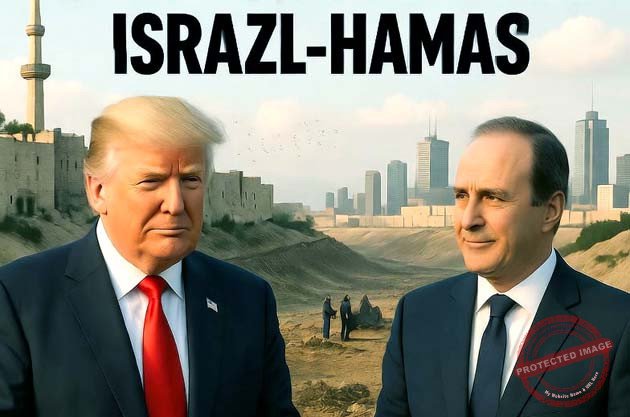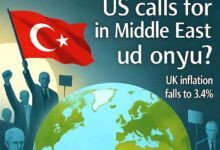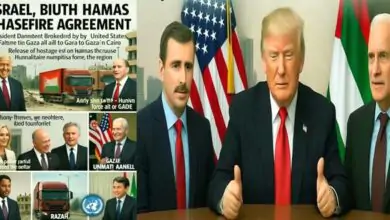
India News Reporter International Desk | Jerusalem/Tel Aviv/Gaza City | October 11, 2025 | Gaza Ceasefire: In a seismic shift that has reverberated across the globe, the two-year-old inferno of conflict between Israel and Hamas flickered toward an uneasy truce on Friday, as the first phase of a U.S.-brokered ceasefire agreement sprang to life. Displaced Palestinians, their faces etched with a cocktail of exhaustion and tentative hope, began the arduous trek northward through Gaza’s scarred landscape, stepping over rubble-strewn roads that once buzzed with the rhythms of daily life. Israeli forces, in a choreographed pullback, receded from key positions in the enclave, marking the end of relentless ground operations that had claimed tens of thousands of lives and reduced entire neighborhoods to dust.
The deal, unveiled with fanfare by U.S. President Donald Trump on October 8, 2025, amid the somber second anniversary commemorations of the Hamas-led assault on Israel, promises a phased release of captives and prisoners, a halt to hostilities, and the faint outline of humanitarian corridors. Yet, as families reunite in tear-streaked embraces and aid convoys rumble toward the battered territory, dark undercurrents swirl: Will this be a genuine dawn or merely a deceptive interlude in the region’s endless cycle of violence? World leaders, from Paris to Beijing, have hailed the breakthrough while issuing veiled warnings, underscoring the high-stakes gamble at play.
The Anatomy of the Agreement: A Delicate Exchange
At its core, the ceasefire codenamed ‘Phase One: Dawn of Release’ by White House officials—hinges on a meticulously negotiated prisoner swap that cuts to the heart of the protracted agony. Hamas, the Islamist militant group governing Gaza, committed to freeing 20 Israeli hostages believed to be alive, alongside the remains of 28 others held since the October 7, 2023, rampage that killed 1,200 Israelis and shattered the nation’s sense of invulnerability. In a reciprocal gesture, Israel greenlit the liberation of over 1,000 Palestinian detainees, including high-profile figures from Gaza arrested during the war’s escalation. A preliminary list of 250 such prisoners, shared by Israeli authorities on October 10, includes teenagers convicted of stone-throwing and seasoned militants alike, a roster that has already ignited fierce domestic debates in Jerusalem.
Israeli Prime Minister Benjamin Netanyahu’s cabinet, after hours of heated deliberations, approved the plan on October 9, with Foreign Minister Gideon Saar declaring on Fox News that a full ceasefire would ignite ‘immediately after’ ratification, paving the way for the war’s denouement. ‘This should bring the end to this war,’ Saar asserted, his words a beacon for a public weary of endless sirens and blackouts. By midday Friday, the first trickle of releases materialized: Three Israeli captives Eliya Cohen, Omer Shem Tov, and Omer Wenkert emerged from captivity in a Hamas-orchestrated ceremony in Gaza, their gaunt frames shielded by armed guards before being ferried to waiting Egyptian intermediaries. Cheers erupted at Tel Aviv’s Hostages Square, where volunteers from the ‘Shirt Team’ a grassroots collective that has peddled solidarity merchandise for nearly two years danced amid a sea of Trump-masked revelers.
On the Palestinian side, the mood was more muted triumph laced with grief. In Gaza City’s labyrinthine ruins, families sifted through the debris of homes pulverized by Israeli airstrikes, their return facilitated by the IDF’s withdrawal from northern corridors. ‘We’ve waited two years for this moment, but what home awaits us?’ lamented Aisha al-Masri, a mother of four, as she navigated a cratered street in Beit Hanoun, her children clutching salvaged toys amid the acrid scent of cordite. The United Nations estimates over 7,800 patients mostly children have been medically evacuated from Gaza since the war’s outbreak, yet the enclave’s healthcare system teeters on collapse, with acute malnutrition claiming 151 young lives in recent months alone.
Trump, who has styled himself as the ultimate dealmaker in this high-wire diplomacy, announced his intent to jet to the Middle East imminently, with plans to address Israel’s Knesset in Jerusalem and convene with Egyptian counterparts in Cairo. ‘This is peace through strength the art of the deal on steroids,’ the president quipped during a White House roundtable, flanked by Secretary of State Marco Rubio, who credited ‘relentless backchannel pressure’ on Doha and Tehran for greasing the wheels. The U.S. leader’s personal stake deepened with reports of his aim to witness a hostage handover in Israel, a theatrical flourish underscoring Washington’s outsized role.
Global Echoes: Jubilation, Skepticism, and Seismic Ripples
The world’s reaction unfurled like a tapestry of guarded optimism. French President Emmanuel Macron tweeted his endorsement, calling the accord ‘a vital step toward de-escalation and justice,’ while urging all parties to honor the fragile pact. In India, Prime Minister Narendra Modi echoed the sentiment during a bilateral huddle with visiting UK counterpart Keir Starmer, framing the ceasefire as a ‘beacon for multilateral harmony’ amid discussions on an impending free trade pact brimming with ‘unparalleled opportunities.’ Yet, not all voices sang in unison. Hamas spokesperson Sami Abu Zuhri hailed the deal as a ‘victory for the resistance,’ but Hamas itself secured U.S. assurances that ‘the war has ended indefinitely,’ a clause that irked hardliners in Tehran. Iran’s regime, long accused of bankrolling Hamas proxies, issued a duplicitous statement feigning support for ‘any initiative ending the genocidal war,’ even as state media decried it as a capitulation to ‘Zionist aggression.’ Analysts speculate Tehran may pivot to Gulf diplomacy to reclaim lost sway, especially after Israel’s strike on a Hamas parley in Qatar last month.
The ceasefire’s shockwaves extended beyond the Levant. In the Philippines, a magnitude 7.4 earthquake rattled Mindanao on October 10, prompting tsunami alerts and drawing parallels to Gaza’s humanitarian quagmire as the world juggles multiple crises. Financial markets, too, felt the tremor: Global stocks dipped amid geopolitical jitters, with the Dow Jones shedding 0.52% to 46,358.42, while gold rocketed past $4,000 an ounce for the first time, a safe-haven surge fueled by lingering Middle East volatility. JPMorgan CEO Jamie Dimon warned of a ‘significant correction’ looming in U.S. equities, citing remilitarization and fiscal strains as harbingers of turbulence.
In the U.S., the Trump administration moved swiftly to capitalize, initiating ‘substantial’ layoffs in the federal workforce via reduction-in-force notices, a populist salvo aimed at streamlining bureaucracy but criticized as a distraction from domestic woes. Meanwhile, World Mental Health Day observances on October 10 spotlighted ‘Mental Health in Humanitarian Emergencies,’ a theme eerily resonant with Gaza’s plight, where trauma festers unchecked.
Lingering Shadows: The Road to ‘Phase Two’?
As the sun dipped over the Mediterranean on October 11, the true litmus test loomed. Phase One’s 72-hour window for full hostage repatriation set to culminate early next week carries no ironclad guarantees against spoilers. Israeli hawks, including National Security Minister Itamar Ben Gvir, have railed against the prisoner releases, while Hamas factions splinter over the permanence of the truce. Aid agencies, led by the WHO, clamor for unfettered access to deliver vaccines and nutrition, amid reports of a ‘trust crisis’ eroding global health confidence.
For the 48 remaining Israeli hostages whose fates hang in the balance and the countless Gazans navigating a homeland of ghosts, this ceasefire is no panacea. It is a precarious bridge, suspended over an abyss of unresolved grievances, from the West Bank’s simmering unrest to Iran’s shadowy machinations. As Trump prepares his regional pilgrimage, the world watches breathlessly: Will hope endure, or will the shadows reclaim the dawn?
(India News Reporter remains committed to unpacking the interconnected threads of global affairs, from the sands of Gaza to the corridors of power in Delhi and beyond. For updates, follow our live coverage).








